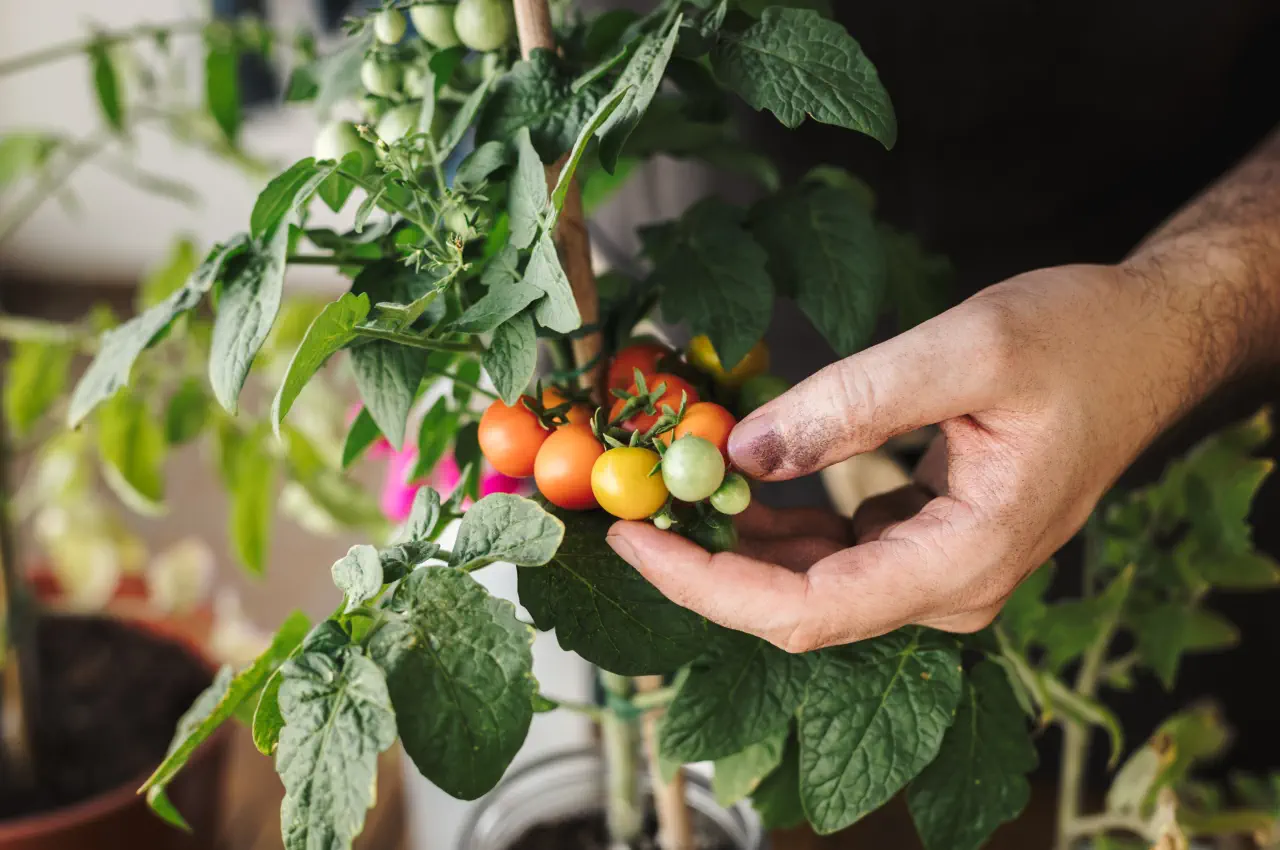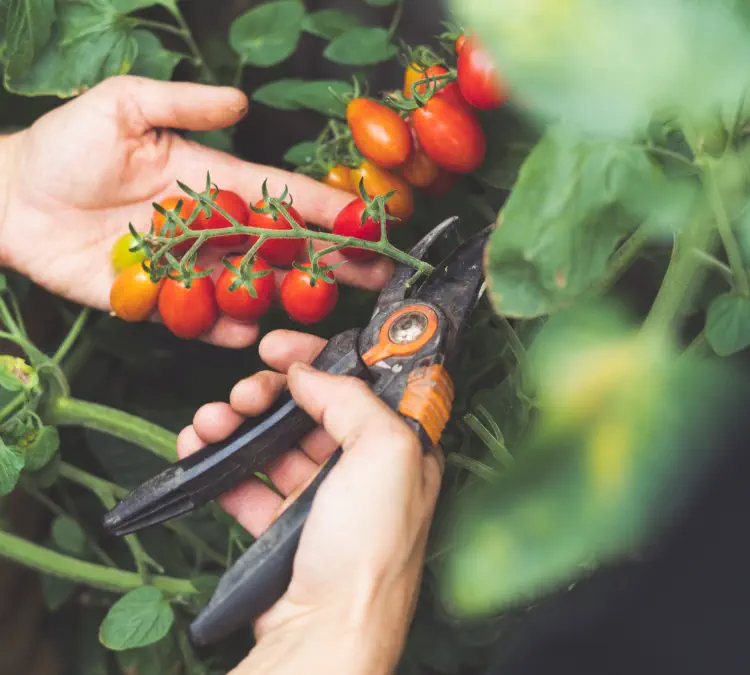Want to know about the types of chilli peppers and what makes them different?
In this blog we’ll cover a wide range of chilli varieties, heat levels, flavours and uses in the kitchen....

If you’re standing in your garden and wondering when to pick your tomatoes? You’ve come to the right place. It’s a combination of colour, touch and knowing your tomato variety. This will help you know exactly when to pick for maximum taste. Read on to find out when to pull your tomatoes off the vine for best flavour....
Growing your own tomatoes gives you control over the quality and the timing of harvest. Timing of harvest plays a big role in flavor of your tomatoes. Why? Because the right time can make the difference between a good tomato and a great one.
To master this timing you’ll need to pay attention to three things: visual ripeness indicators, the feel of the fruit and your tomato variety. Let’s get into it.
The first and most obvious sign of a ripe tomato is color. A fully ripe tomato will be uniform in color with no green near the stem. This mature color will vary depending on the variety of tomato you’re growing so always check the seed packet or catalog for guidance.
Once the tomato shows its mature color all over, it’s probably ready to eat. So keep an eye out for that color change!
Color isn’t the only indicator of ripeness. The feel of the fruit can also give you clues. When you gently squeeze a ripe tomato it should yield to pressure, an unripe one will be hard. Ripe tomatoes will also come off the vine with a slight twist. A gentle pull will tell you if the tomato is ready to be picked, ripe ones will come off the stem easily.
For example the beefsteak tomato is ready to eat when it’s full color and yields slightly to pressure.
Knowledge is power and knowing your tomato varieties will greatly improve your harvest. Different tomato varieties have their own ripening signs and timelines. Early maturing varieties can be ready in as little as 8 weeks, late maturing varieties can take up to 12 weeks. Knowing the characteristics of your tomato variety (color change and softening) will help you time your harvest for maximum flavor. Always check the seed packet or plant tag for the info.
Now that we know when to harvest our tomatoes we can get into the methodology of harvesting. Picking tomatoes is more than just pulling fruit off a plant. It’s a delicate process of selecting ripe, healthy tomatoes and removing them from the plant without damage.
The best ways to do this are a gentle twist, using shears or for efficiency harvesting entire clusters. We’ll get into each method.
The simplest way to harvest tomatoes is the gentle twist. This is a twist until the tomato comes free from the stem. Be gentle, don’t damage the tomato or the plant.
Grip the tomato during the twist and if done right it should come off with the calyx and a small piece of the stem. This is a sign you did the twist-harvest right!

For larger tomatoes or those with tougher stems, garden secateurs are a gardener’s best friend. They allow you to cut the stem just above the fruit without damaging the tomato or plant. You can also use the secateurs on the main stem to cut the fruiting branch and harvest multiple tomatoes at once.
This is good for the heirloom tomato vines.
If you have smaller tomato varieties like cherry or grape it’s best to harvest in clusters. Once most of the fruit in a cluster is ripe you can remove the whole cluster. This saves time and keeps the tomatoes longer, prevents fruit flies and allows for better air circulation around the fruit.
So when you see a cluster of ripe fruit, snip the stem and enjoy!
Sometimes despite our best efforts nature throws us a curveball. Unfavorable weather, pests or disease can force us to harvest our tomatoes earlier than we want. This is called preemptive picking.
But don’t worry. An early harvest doesn’t mean you have to compromise on flavor. With the right knowledge and technique you can still eat delicious tomatoes.
Weather can play a big role in your tomato harvest. If frost is forecasted harvest your tomatoes early to prevent damage. If temperatures are going to drop pick your tomatoes at the mature green stage and let them ripen indoors at room temperature.
Tomatoes that are just starting to show color can also be harvested and let ripen off the vine to protect them from weather and unripe tomatoes. But vine ripened tomatoes have a unique flavor that many gardeners and chefs prefer over a single vine ripened tomato.
Pests and disease are another reason you might need to preemptively pick. Pests are more prevalent as fruit ripens on the vine and disease can spread quickly and destroy your whole crop. Regular checks for disease like blight are crucial especially in the U.K. where it’s common during warm and wet weather.
Harvesting early can mitigate these risks and still let you enjoy your tomatoes so harvesting tomatoes is rewarding.
Whether you had to pick your tomatoes early or want to extend your harvest season there’s good news! Tomatoes can still ripen off the vine thanks to a natural hormone called ethylene gas. Indoor ripening methods tap into this gas and provide the right conditions for your tomatoes to reach their full flavor.
Ethylene gas is a natural plant hormone that’s involved in the ripening of tomatoes. Placing your tomatoes near fruits that produce ethylene like bananas can speed up the process. Simply put your tomatoes with bananas in a paper sack or cardboard box at 70-75°F and you’ll get faster and more uniform ripening.
You can also check the color change at the blossom end of the tomato, a good indicator that ethylene production has started and ripening has begun.
Besides ethylene gas the right temperature and environment are key to indoor ripening. Tomatoes ripen best when allowed to ripen indoors at 75-85°F during the day and 60-70°F at night. Remember to put your tomatoes in a bright area of the room but not in direct sunlight. And make sure they don’t touch each other.
Follow these and your tomatoes will ripen in a week!
You harvested your tomatoes at the right time now what? Storing your tomato bounty properly is just as important to enjoy their full flavor. Whether you want to use your freshly picked tomatoes in the next few days or preserve them for longer we’ve got you covered.
We’ll look into the best ways to store your tomatoes at room temperature and some methods for long term preservation.
Storing ripe tomatoes in the refrigerator is a common mistake. Cold temperatures can change their natural flavor and make them tasteless. Instead keep your ripe tomatoes in a cool, dry place at room temperature. If you’ll use them in a few days this is the way to go.
Unripe tomatoes can be stored at room temperature away from direct sunlight to ripen.
If you had a big harvest and can’t use all your tomatoes right away long term preservation methods are your savior. Freezing whole tomatoes is a simple way to extend their shelf life for up to 6 months. When you need them you can defrost them at room temperature in about an hour.
Converting your ripe tomatoes into homemade sauce and freezing it is another great preservation method. This way you’ll have a ready to use ingredient for future meals.
Are you growing heirloom or green tomatoes? These varieties need a little extra care. Heirloom tomatoes are more prone to splitting and often need to be harvested before they’re fully ripe. Green tomatoes can be a great ingredient in the kitchen, with unique flavors and culinary uses.
Let’s look into the special handling requirements of these varieties.
Heirloom tomatoes are old fashioned varieties that have been handed down through generations. They can be more fragile than modern hybrids and are more prone to splitting from sudden changes in moisture.
The solution is to harvest them when they’re half to three-quarters ripe so you won’t over ripen, split or decay. With proper handling and care you can enjoy the unique and rich flavors of heirloom tomatoes!
If you find yourself with a bunch of green tomatoes at the end of the season don’t panic! These unripe fruits can be a great ingredient in the kitchen with unique flavors and culinary uses. Here are some ideas for using green tomatoes:
Make salsa verde
Bake into a pie
Pickle them
Fry into green tomato slices
Use in green tomato chutney
Green tomatoes including cherry tomatoes are so versatile and can add a great twist to your recipes like fried green tomatoes or green tomato salsa.
So when you have a bunch of green tomatoes consider trying new recipes.
Your Tomato Plants
Growing tomatoes is rewarding but it doesn’t stop at harvest. Regular monitoring and care of your tomato plants is key to an abundance of harvests throughout the season. And even after the first harvest your plants still need love and care to maximize yield and use up the tomatoes.
We’ll go into how to check your plants and post harvest care.
Checking Plants
Being a successful tomato gardener is more than just planting and harvesting. Checking your tomato plants regularly can help you catch problems early and keep your plants healthy and happy. From monitoring for diseases like blight to making sure they’re watered and fertilized regularly checking can make a big difference in your harvest.
Post-Harvest Plant Care
You might think your work is done after the first harvest. But post harvest care is just as important. Pruning your tomato plants can help the plant focus its energy into ripening the fruit already on the plant.
Reducing water and removing plants from the garden after the season is also important to manage disease and prepare the bed for next season.
Conclusion
Growing and harvesting your own tomatoes is a journey. From learning when to harvest to how to harvest to how to store and preserve your bounty you now have the knowledge to get the most out of your tomato plants. Remember the key to a great tomato harvest is to observe and understand your plants. With these tips and techniques you’re on your way to a big harvest of perfectly ripe delicious tomatoes.